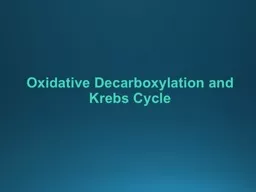

Objectives Oxidative Decarboxylation By the end of this lecture students are expected to Recognize the various fates of pyruvate Define the conversion of pyruvate to acetyl CoA Discuss the major regulatory mechanisms for PDH complex ID: 907965
Download Presentation The PPT/PDF document "Oxidative Decarboxylation and Krebs Cycl..." is the property of its rightful owner. Permission is granted to download and print the materials on this web site for personal, non-commercial use only, and to display it on your personal computer provided you do not modify the materials and that you retain all copyright notices contained in the materials. By downloading content from our website, you accept the terms of this agreement.
Slide1
Oxidative Decarboxylation and Krebs Cycle
Slide2Objectives: Oxidative Decarboxylation
By the end of this lecture, students are expected to:
Recognize the various fates of pyruvate
Define the conversion of pyruvate to acetyl CoA
Discuss the major regulatory mechanisms for PDH complex
Recognize the clinical consequence of abnormal oxidative decarboxylation reactions
Slide3Objectives: Krebs Cycle
By the end of this lecture, students are expected to:
Recognize the importance of Krebs cycle
Identify
various reactions of Krebs cycle
Define the regulatory mechanisms of Krebs cycle
Assess the energy yield of PDH reaction and Krebs cycle’s reactions
Slide4Fates of Pyruvate
Glutamate
αKG
ALT
Alanine
PLP
PLP = Pyridoxal Phosphate
Slide5Oxidative Decarboxylation of Pyruvate
Allosteric
Regulation
Slide6PDH Complex: Covalent Regulation
Slide7PDH Reaction: Clinical application
Deficiencies of thiamine or niacin can cause serious CNS problems.
WHY
?
Brain cells are unable to produce sufficient ATP if the PDH complex is inactive
.
Wernicke-
Korsakoff
(encephalopathy-psychosis syndrome) due to thiamine deficiency, may be seen especially with alcohol abuse.PDH complex deficiency is the most common biochemical cause of congenital lactic acidosis.
Slide8Krebs Cycle
The tricarboxylic acid cycle (Krebs) shown as a part of the essential pathways of energy metabolism.
CoA = coenzyme A.
Slide9Tricarboxylic Acid Cycle: Krebs Cycle
Final
common pathway for
oxidation
Exclusively
in mitochondria
Major source for ATP
Mainly catabolic with some anabolic features
Synthetic reactions (anabolic features): Glucose from amino acids Nonessential amino acids Fatty acids Heme
Slide10Krebs Cycle Reactions (1)
Formation of
α-
ketoglutarate from acetyl coenzyme A (CoA) and
oxaloacetate.
NAD(H
) = Nicotinamide adenine dinucleotide.
Slide11Krebs Cycle Reactions (2)
Succinate
Thiokinase
Substrate-Level
Phosphorylation
Formation of malate from
α-
ketoglutarate.
NAD(H
) = nicotinamide adenine
dinucleotide
GDP = guanosine diphosphate;P = phosphateFAD(H2) = flavin adenine dinucleotide.
Slide12Krebs Cycle Reactions (3)
Formation (regeneration) of oxaloacetate from malate.
NAD(H
) = nicotinamide adenine dinucleotide
Slide13Krebs Cycle: Energy Yield
Number of ATP molecules produced from the oxidation of one molecule of acetyl coenzyme A (CoA) using both substrate-level and oxidative phosphorylation.
Slide14Krebs Cycle: Energy Yield
Number of ATP molecules produced from the oxidation of one molecule of acetyl coenzyme A (CoA) using both substrate-level and oxidative phosphorylation.
Slide15Net ATP Production by
Complete Glucose Oxidation
Aerobic glycolysis:
8
ATP
Oxidative decarboxylation:
2 X 3 = 6 ATPKrebs cycle: 2 X 12 = 24 ATPNet:
38 ATP
Slide16Regulation of Oxidative Decarboxylation and Krebs Cycle
PDH complex and the TCA cycle are both
up-regulated
in response to a
decrease in the ratio
of
ATP:ADP
NADH:NAD
+
TCA cycle activators are:ADP
Ca2+ TCA cycle inhibitors are:ATPNADH
Slide17Take Home Message
Pyruvate is oxidatively decarboxylated by PDH
to acetyl
CoA inside the mitochondria
Krebs cycle:
Final
common pathway for the oxidation of carbohydrates, fatty acids and amino acids
Occurs
in the mitochondria
Aerobic Mainly catabolic, with some anabolic reactionsThe complete oxidation of one glucose molecule results in a net production of 38 ATP molecules
Slide18Reference
Lippincott Illustrated Review of Biochemistry, 6
th
edition, 2014, Unit
2,
Chapter
9,
Pages
109-116.